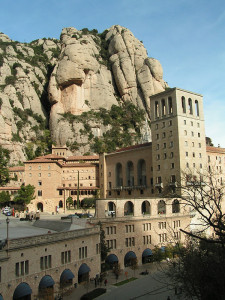
This special feature of the “Conservation Experiences” is based on an interesting case developed by the Delos Initiative. The Delos initiative is well know for its work on Sacred Natural Sites in developed countries since 2005. The work presented in this feature is based on the monastic community that hosted the first Delos Workshop in 2006 at Montserrat, Cataluña. On behalf of the Delos

The Monastery of Montserrat is located only 50 kilometres away from the Barcelona metropolitan area. It receives about 3 million visitors every year and yet hosts a unique serene environment with several important plant and animal species. Photo: Bas Verschuuren
Initiative Co-Coordinator of Mr. Josep-Maria Mallarach has been involved with the process around this conservation initiative which engaged the many stakeholders in and around the park. Mr. Mallarach is a dedicated protected area and conservation professional with a specialisation in cultural and spiritual values of nature. He suported an excellent documentation centre which features publications on the subject with Silene Association and for Spanish speakers he recently helped develop a guidance manual to incorporate the intangible heritage on cultural and spiritual values into protected areas. Click here to read the full case study on “Tourism and holiness at Montserrat monastic community, Catalonia, Spain”.
Many consider the amazing rock pinnacles and the monasteries on Montserrat to be the spiritual heart of Catalonia. Located within the Barcelona Metropolitan Area they are only 50 km away from the city located in a protected area. The male Benedictine monastic community of Montserrat has lived on the mountain for almost a millennium. Throughout the centuries hermits have occupied isolated shelters located in the most remote and often upper regions of the rock formation. Silence and contemplation should remain central in this respected holy natural site, and management plans are directed that way.
The local Benedictine monastic community has taken care of Montserrat since they settled there in 1025. Montserat has always attracted pilgrims but since the ‘80s, Montserrat has welcomed increasing numbers of visitors, estimated to be in the tens of millions. Together with the Board of the protected area and local municipalities, the monks have worked to preserve the unique natural, cultural and religious values of Montserrat and shield it against threats posed by the growing metropolis in the vicinity.
This park is unique in the fact that the management board is presided by the Catalan president while the head abbot of the Monastery of Santa Maria serves as a Vice president. Monastic monks represent their community in all major local groups. Relationships with the four surrounding municipalities are generally complex but positive. While in the past there have been conflicts on resource use, the monastic community now engages in meaningful dialogue with local town councils which helps releasing the pressure that can build up in conflict situations. A private enterprise was created by the monastic community in 1912, serving to manage all public services around the Monastery. Recently, the Monastery also allied with the Delos Initiative of IUCN to deepen and broaden the efforts in integrating the intangible heritage in nature conservation.
Click here to read the full case study on “Tourism and holiness at Montserrat monastic community, Catalonia, Spain” and find further references to the work of the Delos Initiative.






